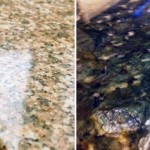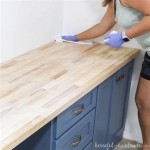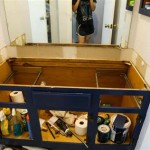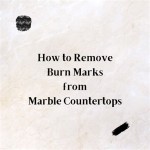How to Clean Marble Countertops in the Bathroom
Marble countertops add a touch of elegance and sophistication to any bathroom. However, their porous nature makes them susceptible to staining and etching from common bathroom products. Proper cleaning and maintenance are crucial to preserving the beauty and integrity of marble countertops for years to come. This article provides a comprehensive guide to cleaning marble countertops in the bathroom, outlining the necessary materials, step-by-step cleaning procedures, and essential preventative measures.
Understanding Marble: Composition and Vulnerabilities
Marble is a metamorphic rock composed primarily of calcium carbonate. This composition makes it relatively soft compared to other countertop materials like granite or quartz. The calcium carbonate reacts readily with acidic substances, leading to etching, which is the dulling or roughening of the surface. Common culprits in the bathroom include toothpaste, mouthwash, shaving cream, and various cleaning products. Additionally, marble's porosity allows liquids to penetrate, potentially causing stains from spills if not promptly addressed.
Before embarking on the cleaning process, it's essential to understand the specific vulnerabilities of marble. This knowledge will inform the choice of cleaning agents and techniques, minimizing the risk of damage. Avoid harsh chemicals, abrasive cleaners, and scouring pads, as these can scratch and dull the surface, diminishing its natural luster.
Essential Materials for Cleaning Marble Countertops
Gathering the necessary materials before starting the cleaning process ensures efficiency and minimizes the risk of using inappropriate products when faced with a spill. The following items are recommended:
*pH-Neutral Cleaner:
This is the most important element. A pH-neutral cleaner specifically formulated for marble is essential. These cleaners are designed to gently remove dirt and grime without damaging the stone. Avoid cleaners containing lemon, vinegar, ammonia, bleach, or other acids or alkalis. *Soft Microfiber Cloths:
Microfiber cloths are ideal for cleaning marble because they are gentle and non-abrasive. Use separate cloths for cleaning, rinsing, and drying. *Spray Bottle (Optional):
A spray bottle can be useful for applying the cleaning solution evenly. *Warm Water:
Use warm water for rinsing the countertops. Avoid using hot water, as it can sometimes damage certain sealants. *Baking Soda (For Stains):
Baking soda can be used to create a paste for treating stains. However, use it sparingly and with caution, as it can be mildly abrasive. *Hydrogen Peroxide (For Organic Stains):
Hydrogen peroxide can be used for removing organic stains like mildew. *Marble Sealer:
A high-quality marble sealer is essential for protecting the countertop from stains and etching. *Soft Brush (Optional):
A soft-bristled brush, like a toothbrush, can be used to gently scrub hard-to-reach areas, such as around the sink or faucet.Daily Cleaning Routine for Marble Countertops
Establishing a daily cleaning routine is the most effective way to prevent buildup and maintain the beauty of marble countertops. The following steps should be incorporated into the daily routine:
1.Wipe Up Spills Immediately:
This is the most important step in preventing stains. Blot up any spills, especially acidic substances like toothpaste, mouthwash, or spilled beverages, immediately with a soft, dry cloth. Avoid rubbing, as this can spread the spill and potentially scratch the surface. 2.Rinse the Countertop:
After wiping up spills, rinse the countertop with warm water. This will remove any remaining residue and prevent it from drying on the surface. 3.Dry the Countertop:
Use a clean, dry microfiber cloth to thoroughly dry the countertop. This will prevent water spots and streaks from forming.Weekly or Bi-Weekly Cleaning Procedure
In addition to the daily routine, a more thorough cleaning should be performed weekly or bi-weekly. This will remove any accumulated dirt, grime, and soap scum.
1.Dust the Countertop:
Use a soft, dry microfiber cloth to dust the countertop. This will remove any loose dirt and debris. 2.Prepare the Cleaning Solution:
Dilute the pH-neutral marble cleaner according to the manufacturer's instructions. If using a spray bottle, fill it with the diluted solution. 3.Apply the Cleaning Solution:
Spray the cleaning solution evenly over the countertop. 4.Wipe the Countertop:
Use a clean, damp microfiber cloth to wipe the countertop. Avoid using excessive pressure, as this can scratch the surface. For stubborn grime, allow the cleaning solution to sit on the surface for a few minutes before wiping. 5.Rinse the Countertop:
Rinse the countertop thoroughly with warm water. Ensure all traces of the cleaning solution are removed. 6.Dry the Countertop:
Use a clean, dry microfiber cloth to thoroughly dry the countertop.Addressing Stains and Etch Marks
Despite diligent cleaning efforts, stains and etch marks can sometimes occur. The following methods can be used to address these issues:
*Stains:
*Organic Stains (Coffee, Tea, Wine, Mildew):
Create a paste of hydrogen peroxide and baking soda. Apply the paste to the stain and cover it with plastic wrap. Let it sit for several hours or overnight. Remove the plastic wrap and wipe away the paste with a damp cloth. Rinse thoroughly and dry. *Oil-Based Stains (Cosmetics, Lotions):
Create a paste of baking soda and water. Apply the paste to the stain and let it sit for several hours or overnight. Wipe away the paste with a damp cloth. Rinse thoroughly and dry. *General Stains:
A poultice can be made with absorbent materials like diatomaceous earth mixed with the appropriate solvent for the stain type. Follow the specific instructions for the poultice material. *Etch Marks:
* Mild etch marks can sometimes be buffed out with a marble polishing compound. Follow the manufacturer's instructions carefully. For deeper etch marks, professional restoration may be required. It’s advisable to consult a stone restoration expert to avoid further damage.It's important to test any cleaning solution or stain removal method in an inconspicuous area before applying it to the entire countertop. This will help to ensure that the method does not damage the marble.
Preventative Measures to Protect Marble Countertops
Preventing stains and etch marks is easier than removing them. The following preventative measures can help to protect marble countertops:
*Seal the Countertop Regularly:
Sealing the countertop creates a protective barrier that helps to prevent liquids from penetrating the marble. The frequency of sealing depends on the type of sealer used and the level of use the countertop receives. Consult the manufacturer's instructions for the recommended sealing frequency. *Use Coasters and Trays:
Place coasters under drinks and trays under toiletries to protect the countertop from spills and condensation. *Avoid Placing Hot Items Directly on the Countertop:
Hot items can damage the sealant and potentially stain the marble. Use trivets or hot pads to protect the countertop. *Use Gentle Cleaning Products:
Avoid using harsh chemicals, abrasive cleaners, and scouring pads. *Clean Up Spills Immediately:
As mentioned earlier, cleaning up spills immediately is crucial to preventing stains. *Consider a Marble Protector Film:
A protective film can be applied to the countertop to provide an extra layer of protection against scratches, stains, and etch marks. These films are typically clear and virtually invisible.Proper care and maintenance are essential for preserving the beauty and longevity of marble countertops in the bathroom. By following the cleaning procedures and preventative measures outlined in this article, homeowners can enjoy the elegance and sophistication of marble for years to come.

How To Clean Marble In Your Bathroom Unique Vanities

How To Clean Bathroom Countertops Marble Systems Inc

How To Clean Marble In Your Bathroom Unique Vanities

Caring For Your Cultured Marble Countertops R D Inc

How To Clean Bathroom Countertops 4 Steps That Guarantee Results

How To Clean Marble

Maintenance Tips For Stunning Bathroom Countertops R D Marble

How To Clean And Maintain Quartz Marble Vanity Tops

How To Clean Marble Bathrooms In 5 Easy Steps Riluxa Com

7 Tips You Must Follow To Clean Quartz Bathroom Countertops
See Also








